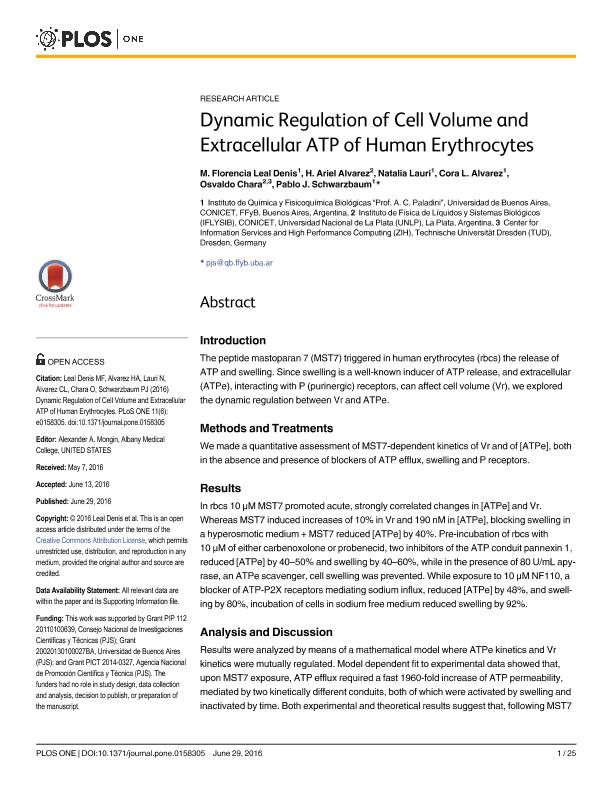Artículo
Dynamic Regulation of Cell Volume and Extracellular ATP of Human Erythrocytes
Leal Denis, Maria Florencia ; Alvarez, Hugo Ariel
; Alvarez, Hugo Ariel ; Lauri, Natalia; Alvarez, Cora Lilia
; Lauri, Natalia; Alvarez, Cora Lilia ; Chara, Osvaldo
; Chara, Osvaldo ; Schwarzbaum, Pablo Julio
; Schwarzbaum, Pablo Julio
 ; Alvarez, Hugo Ariel
; Alvarez, Hugo Ariel ; Lauri, Natalia; Alvarez, Cora Lilia
; Lauri, Natalia; Alvarez, Cora Lilia ; Chara, Osvaldo
; Chara, Osvaldo ; Schwarzbaum, Pablo Julio
; Schwarzbaum, Pablo Julio
Fecha de publicación:
06/2016
Editorial:
Public Library of Science
Revista:
Plos One
ISSN:
1932-6203
Idioma:
Inglés
Tipo de recurso:
Artículo publicado
Clasificación temática:
Resumen
Introduction: The peptide mastoparan 7 (MST7) triggered in human erythrocytes (rbcs) the release of ATP and swelling. Since swelling is a well-known inducer of ATP release, and extracellular (ATPe), interacting with P (purinergic) receptors, can affect cell volume (Vr), we explored the dynamic regulation between Vr and ATPe. Methods and Treatments: We made a quantitative assessment of MST7-dependent kinetics of Vr and of [ATPe], both in the absence and presence of blockers of ATP efflux, swelling and P receptors. Results: In rbcs 10 μM MST7 promoted acute, strongly correlated changes in [ATPe] and Vr. Whereas MST7 induced increases of 10% in Vr and 190 nM in [ATPe], blocking swelling in a hyperosmotic medium + MST7 reduced [ATPe] by 40%. Pre-incubation of rbcs with 10 μM of either carbenoxolone or probenecid, two inhibitors of the ATP conduit pannexin 1, reduced [ATPe] by 40–50% and swelling by 40–60%, while in the presence of 80 U/mL apyrase, an ATPe scavenger, cell swelling was prevented. While exposure to 10 μM NF110, a blocker of ATP-P2X receptors mediating sodium influx, reduced [ATPe] by 48%, and swelling by 80%, incubation of cells in sodium free medium reduced swelling by 92%. Analysis and Discussion: Results were analyzed by means of a mathematical model where ATPe kinetics and Vr kinetics were mutually regulated. Model dependent fit to experimental data showed that, upon MST7 exposure, ATP efflux required a fast 1960-fold increase of ATP permeability, mediated by two kinetically different conduits, both of which were activated by swelling and inactivated by time. Both experimental and theoretical results suggest that, following MST7 exposure, ATP is released via two conduits, one of which is mediated by pannexin 1. The accumulated ATPe activates P2X receptors, followed by sodium influx, resulting in cell swelling, which in turn further activates ATP release. Thus swelling and P2X receptors constitute essential components of a positive feedback loop underlying ATP-induced ATP release of rbcs.
Archivos asociados
Licencia
Identificadores
Colecciones
Articulos(IFLYSIB)
Articulos de INST.FISICA DE LIQUIDOS Y SIST.BIOLOGICOS (I)
Articulos de INST.FISICA DE LIQUIDOS Y SIST.BIOLOGICOS (I)
Articulos(IQUIFIB)
Articulos de INST.DE QUIMICA Y FISICO-QUIMICA BIOLOGICAS "PROF. ALEJANDRO C. PALADINI"
Articulos de INST.DE QUIMICA Y FISICO-QUIMICA BIOLOGICAS "PROF. ALEJANDRO C. PALADINI"
Citación
Leal Denis, Maria Florencia; Alvarez, Hugo Ariel; Lauri, Natalia; Alvarez, Cora Lilia; Chara, Osvaldo; et al.; Dynamic Regulation of Cell Volume and Extracellular ATP of Human Erythrocytes; Public Library of Science; Plos One; 11; 6; 6-2016; 1-25; e0158305
Compartir
Altmétricas



